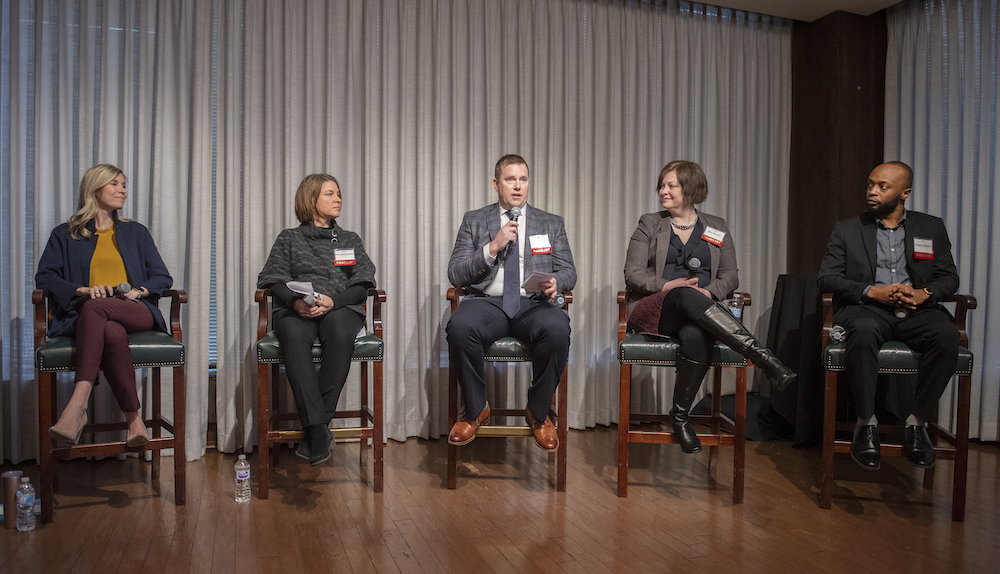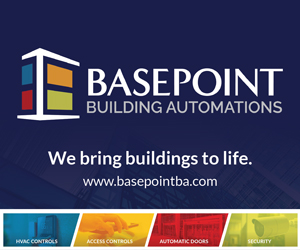6 takeaways from our Power Breakfast on the future of downtown

BPC Staff Feb 18, 2022 | 5:45 pm
6 min read time
1,537 wordsAll Latest News, Arts and Culture, Economic DevelopmentPanelists from left to right: Tiffany Tauscheck, Erin Olson-Douglas, TJ Jacobs, Staci Bennett, Marquas Ashworth
View all photos from the event on Facebook. Photo by Duane Tinkey
In our 2021 Leaders Survey, 73% of respondents said they agreed that downtown small businesses and commercial real estate will suffer if most businesses continue offering remote working to their employees post-pandemic – and another 13% were unsure about the effects. Between changing customer demand and issues with staffing, downtown small businesses are being challenged while office vacancies continue to be higher than they were pre-pandemic. Yet both staple and new events and attractions are continuing on with fervor. Thursday’s Power Breakfast focused on solutions to keep downtown thriving and what the new vision plan might include.
Panelists included:
Tiffany Tauscheck – chief operations officer, Greater Des Moines Partnership.
Staci Bennett – executive director, Des Moines Downtown Chamber.
Marquas Ashworth – entrepreneur, distiller and developer in Des Moines.
Erin Olson-Douglas – director, development services, city of Des Moines.
TJ Jacobs – vice president, CBRE Hubbell Commercial.
Here’s what our reporters took away from the discussion.
Making downtown a location of choice
One of the lasting effects of the pandemic has been the increase in daily decision-making practices. Do I dine out at a busy restaurant while the omicron variant is still prevalent? Do I work from home today or go into the office? The theme of choice was first introduced into the discussion by Olson-Douglas, but was carried on throughout the duration of the conversation. Pre-pandemic, Olson-Douglas said, people would cruise through their days on autopilot, coming downtown in the morning into work before leaving in the afternoon to pick up their kids – because that’s the way it had always been. Now, those decisions of what you choose to do throughout the day and when and where you do them are front-of-mind. Tauscheck followed up later in the discussion by pointing out the need for employers to recognize that the core of the future of work is choice. If employers truly want their employees back in person and full time, what can they do to make that enticing? “We will need to continue as employers to be flexible. We will need to continue to put an emphasis on benefits, salaries,” Tauscheck said. — Emily Kestel
Fostering entrepreneurship and synergy
The discussion made clear that the fundamentals of operation and strategy for downtown businesses are changing, and panelists imagined how entrepreneurs and small business owners will fit into that landscape moving forward. Ashworth said having synergy of the businesses at Center at 6th has been a focus for the development, and he suggested a similar strategy could be helpful for developing synergy among downtown businesses at large, particularly if the area is positioned to have experiential-based businesses that can attract people in a way online businesses can’t. Katherine Harrington, president and CEO of the West Des Moines Chamber of Commerce, volunteered the first question from the audience, asking if vacant real estate downtown could serve as spaces for business incubators to foster more entrepreneurship. As more Americans are pursuing entrepreneurial ventures, panelists said ideas like that need to be part of Des Moines’ plan for downtown business development. Olson-Douglas said Des Moines is well positioned to advance entrepreneurship because it’s both large enough to “do some really complex and interesting things,” but small enough that people who can help are accessible. She and Ashworth both noted that another part of the equation is financial resources and support to guide entrepreneurs to their first and next steps. — Sarah Bogaards
Measuring downtown’s success
The panelists were asked what indicators they are watching that signals downtown is rebounding from the economic struggles caused by the pandemic. The answer provided by Jacobs was direct: “It’s looking at downtown parking garages and seeing cars in them. It’s seeing traffic on [Interstate Highway] 235. These are just some very anecdotal evidence of vibrancy, in my opinion.” Jacobs said he’s also optimistic about the future of downtown because of the interest in it from people who live in other states. “Right now I’m working with 10 different groups that are out of state and [interested in investing or developing] downtown,” he said. “These folks are coming out of the Des Moines airport and saying, ‘We’re going to invest here.’ … It’s interesting that an out-of-state investor or developer is betting on downtown and we are all kind of wondering, ‘Well, should we?’” — Kathy A. Bolten
Commercial vacancies
Jacobs was asked about downtown commercial vacancies. He said that vacancies are just under 20%, but that there are “shadow vacancies,” or those spaces still being leased but that remain unused because of employees who are still working remotely. Although he didn’t give a specific number, Jacobs said those shadow vacancies would push the vacancy rate higher. He said the current vacancy rate is about 10% higher than a decade ago, but the current dynamic of high vacancy rates and low employment is different from what has been experienced before. “If you go back to the early 2000s dot-com bust as well as 9/11, there was a pullback in office occupancy. In the 2010s during the financial crisis we saw a reduction, but this time is a little bit different in thinking we have 3.5% unemployment but we have the highest vacancy rate we’ve ever had,” he said. “That’s a nice macro point of view for downtown. We have to think about the large blocks of space. In the East Village and south of downtown, a lot of buildings under 100,000 square feet are doing very well. It’s the large blocks of formerly corporate space we’re seeing that’s a little harder to work with.” — Michael Crumb
Optimism and resilience
Olson-Douglas said Des Moines has done a good job of building quality buildings. “We have vacancy space. It’s quality space around downtown. I really feel confident that knowing that we do have good space, we can figure out those sub-tenancy sorts of issues. We can work together and figure out some of those things. It’s too important not to.” Olson-Douglas said it’s not a unique situation to Des Moines and said downtowns across the country are trying to figure out how to solve the commercial vacancy issue. The city also converted a lot of the Class C office space to residential, taking it out of the commercial market. “But we added a level of vibrancy we haven’t seen in downtown ever,” she said. “So we really have positioned ourselves well.” She said, “There are real reasons for optimism for downtown and I think there is a resiliency we have all collectively accomplished through the past two years because of the groundwork we have laid over the last couple of decades.” She cautioned that things could get worse before they get better, but said, “We need to find those solutions. We need to cultivate business expansions. We need to find those consolidations, and we really need to work hard to fill that office space.” — Michael Crumb
Upcoming downtown study highlights importance of cultural draws
Tauscheck dropped a few nuggets from a soon-to-be released study focused on downtown workforce and office occupancy trends that the Partnership has been working on with Des Moines-based consulting firm Baton Global and people analytics platform, Reworc. “We interviewed over 5,100 participants in this study, [asking them], what do they need? How do they feel, not only about downtown, of course, but also, what do they need to do their best work?” While they’re still digging through the data, one of the takeaways Tauscheck shared centered on the panel’s recurring theme of choice. Employers “will need to continue to put an emphasis on benefits and salaries,” she said. “But really, when we think about the future of work, it’s about choice, and as an employer, figuring out ways to make it so enticing to be in the office and around your colleagues.” Just as employers used to spend time planning meaningful off-site meetings and retreats for workers, they now should be thinking about flipping that around to create “moments of connection” for their teams at the office, she said.
“Another key takeaway that we’re really excited about is that the No. 1 draw for people to come downtown is cultural — people want fun stuff to do. And you know what? We’ve got a lot of that,” Tauscheck said, listing some big projects like the newly opened Lauridsen Skatepark, the planned soccer stadium and the ICON Water Trails projects as examples. A majority of survey participants — 86% — said “they would come downtown even more if we continue to invest in our downtown, and make more cool stuff happen,” she said. The DSM Workforce Trends and Occupancy Study, which the Partnership expects to release early next month, is a separate but related research effort from the Downtown DSM: Future Forward study, which is expected to come out sometime this spring, Partnership spokesperson Courtney Shaw told me.
— Joe Gardyasz
Editor’s note: This article has been updated to correct the spelling of Tiffany Tauscheck’s name and to add Reworc, which was omitted in the original article, as a partner in the downtown workforce and occupancy study.










